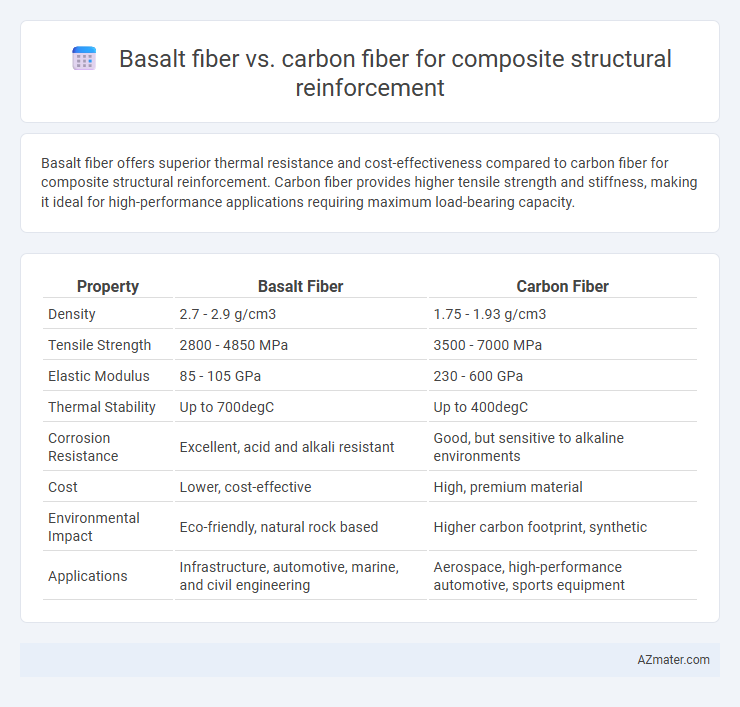Basalt fiber offers superior thermal resistance and cost-effectiveness compared to carbon fiber for composite structural reinforcement. Carbon fiber provides higher tensile strength and stiffness, making it ideal for high-performance applications requiring maximum load-bearing capacity.
Table of Comparison
| Property | Basalt Fiber | Carbon Fiber |
|---|---|---|
| Density | 2.7 - 2.9 g/cm3 | 1.75 - 1.93 g/cm3 |
| Tensile Strength | 2800 - 4850 MPa | 3500 - 7000 MPa |
| Elastic Modulus | 85 - 105 GPa | 230 - 600 GPa |
| Thermal Stability | Up to 700degC | Up to 400degC |
| Corrosion Resistance | Excellent, acid and alkali resistant | Good, but sensitive to alkaline environments |
| Cost | Lower, cost-effective | High, premium material |
| Environmental Impact | Eco-friendly, natural rock based | Higher carbon footprint, synthetic |
| Applications | Infrastructure, automotive, marine, and civil engineering | Aerospace, high-performance automotive, sports equipment |
Introduction to Composite Structural Reinforcement
Basalt fiber and carbon fiber are both advanced materials used in composite structural reinforcement, offering exceptional strength-to-weight ratios and corrosion resistance. Basalt fiber provides a cost-effective alternative with high thermal stability and good mechanical properties, while carbon fiber is renowned for its superior tensile strength and stiffness, making it ideal for high-performance applications. Selection between basalt fiber and carbon fiber depends on the specific structural requirements, environmental conditions, and budget constraints.
Overview of Basalt Fiber
Basalt fiber, derived from volcanic basalt rock, offers high tensile strength, excellent thermal stability, and superior chemical resistance, making it a strong candidate for composite structural reinforcement. Compared to carbon fiber, basalt fiber is more cost-effective and environmentally friendly, with enhanced impact resistance and better performance in corrosive environments. Its natural origin and ease of production contribute to growing applications in construction, automotive, and aerospace industries seeking sustainable yet durable reinforcement materials.
Overview of Carbon Fiber
Carbon fiber is a high-performance synthetic material composed of thin, strong crystalline filaments of carbon, known for its exceptional tensile strength, stiffness, and lightweight properties. It is widely used in composite structural reinforcement for aerospace, automotive, and civil engineering applications due to its superior mechanical performance and resistance to fatigue and corrosion. Compared to basalt fiber, carbon fiber offers higher strength-to-weight ratio and better structural rigidity, making it ideal for demanding load-bearing and high-stress environments.
Mechanical Properties Comparison
Basalt fiber exhibits higher tensile strength than glass fiber but slightly lower than carbon fiber, offering excellent impact resistance and superior thermal stability for composite structural reinforcement. Carbon fiber surpasses basalt fiber in stiffness and tensile modulus, providing exceptional strength-to-weight ratio and fatigue resistance critical for high-performance applications. While carbon fiber composites are preferred for maximum structural rigidity, basalt fiber composites present a cost-effective alternative with enhanced durability and corrosion resistance.
Durability and Environmental Resistance
Basalt fiber exhibits superior environmental resistance compared to carbon fiber, offering enhanced durability against moisture, UV radiation, and chemical exposure, making it ideal for harsh outdoor conditions. Carbon fiber delivers exceptional strength-to-weight ratio but is more susceptible to oxidative degradation and requires protective coatings to maintain long-term performance. Thus, basalt fiber provides a cost-effective, eco-friendly alternative with better longevity in corrosive and variable environmental settings for composite structural reinforcement.
Weight and Density Analysis
Basalt fiber exhibits a density of approximately 2.7 g/cm3, making it heavier than carbon fiber, which has a density around 1.75 g/cm3, contributing to its lighter weight advantage in composite structural reinforcement applications. The lower density of carbon fiber enhances the strength-to-weight ratio, optimizing performance in aerospace and automotive industries where weight reduction is critical. Basalt fiber, while denser, offers competitive mechanical properties and cost-effectiveness but may lead to increased structural mass compared to carbon fiber composites.
Cost and Economic Considerations
Basalt fiber offers a cost-effective alternative to carbon fiber for composite structural reinforcement, with raw material costs typically 30-50% lower than carbon fiber. The manufacturing processes for basalt fiber composites are less energy-intensive, translating to reduced production expenses and more competitive pricing for large-scale construction projects. Despite carbon fiber's superior strength-to-weight ratio, basalt fiber provides an economically advantageous solution with acceptable mechanical performance for various reinforcement applications.
Sustainability and Environmental Impact
Basalt fiber offers significant sustainability advantages over carbon fiber in composite structural reinforcement due to its natural abundance and lower energy consumption during production. Basalt fibers are derived from volcanic rocks, resulting in minimal environmental impact compared to the energy-intensive manufacturing process of carbon fiber, which relies on fossil fuels and has higher carbon emissions. The biodegradability and recyclability of basalt fiber composites further enhance their eco-friendly profile, making them a more sustainable choice for green construction and infrastructure projects.
Applications in Construction and Engineering
Basalt fiber offers superior thermal stability and cost-effectiveness compared to carbon fiber, making it ideal for reinforcing concrete structures, bridges, and seismic retrofitting in construction and engineering. Carbon fiber provides higher tensile strength and stiffness, preferred in aerospace, high-performance structural components, and lightweight load-bearing applications where maximum strength-to-weight ratio is critical. Both fibers enhance durability and corrosion resistance, but basalt fiber's environmental friendliness and lower price point drive its growing adoption in sustainable infrastructure projects.
Choosing the Right Fiber for Reinforcement
Basalt fiber offers excellent chemical resistance, high tensile strength, and superior impact resistance, making it a cost-effective alternative for composite structural reinforcement, especially in corrosive environments. Carbon fiber provides unmatched stiffness, lightweight properties, and exceptional strength-to-weight ratio, ideal for high-performance applications requiring minimal deflection and maximum durability. Selecting the right fiber depends on factors such as mechanical performance requirements, environmental exposure, cost constraints, and long-term durability needs in the composite structure.

Infographic: Basalt fiber vs Carbon fiber for Composite structural reinforcement
 azmater.com
azmater.com